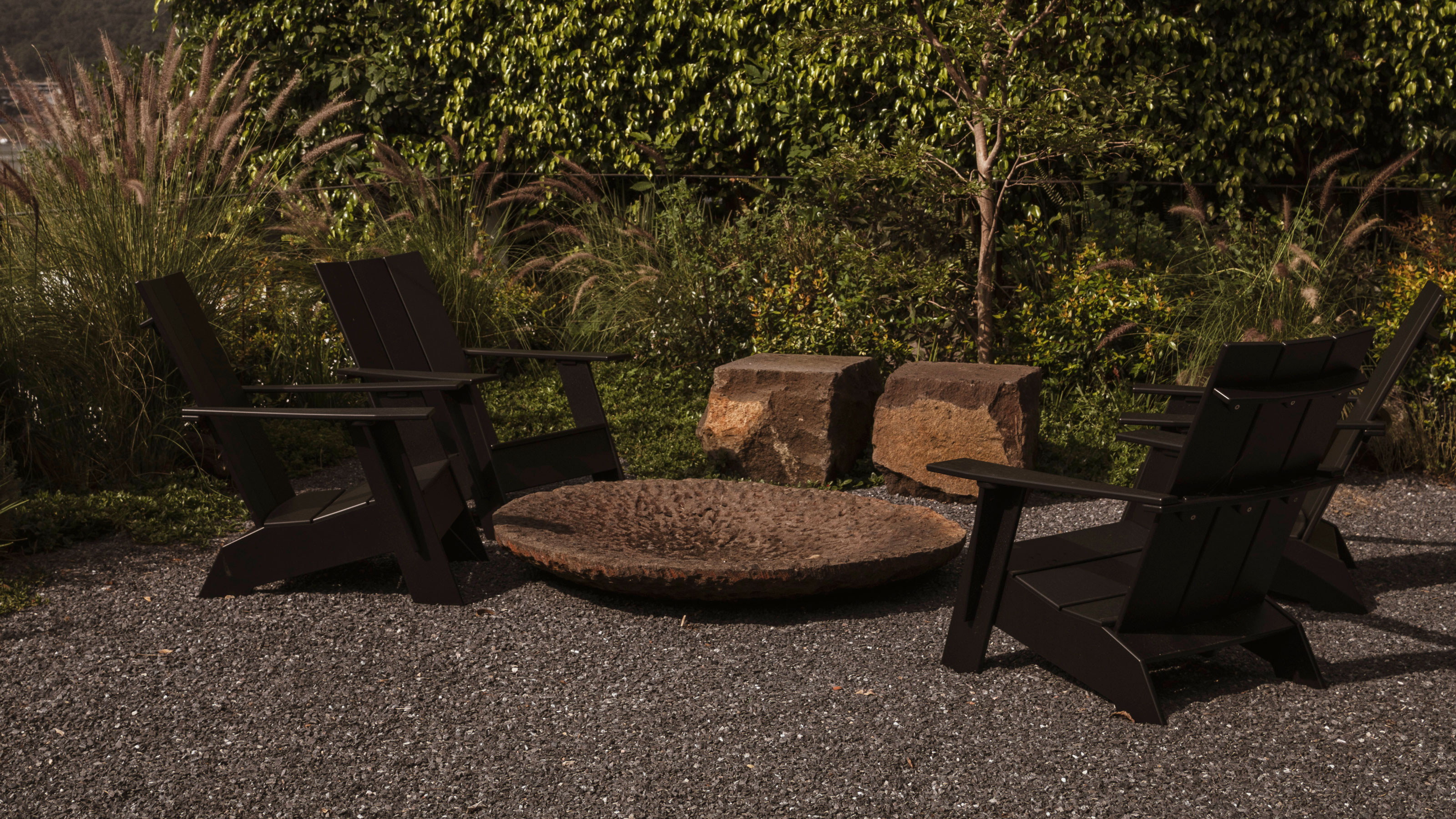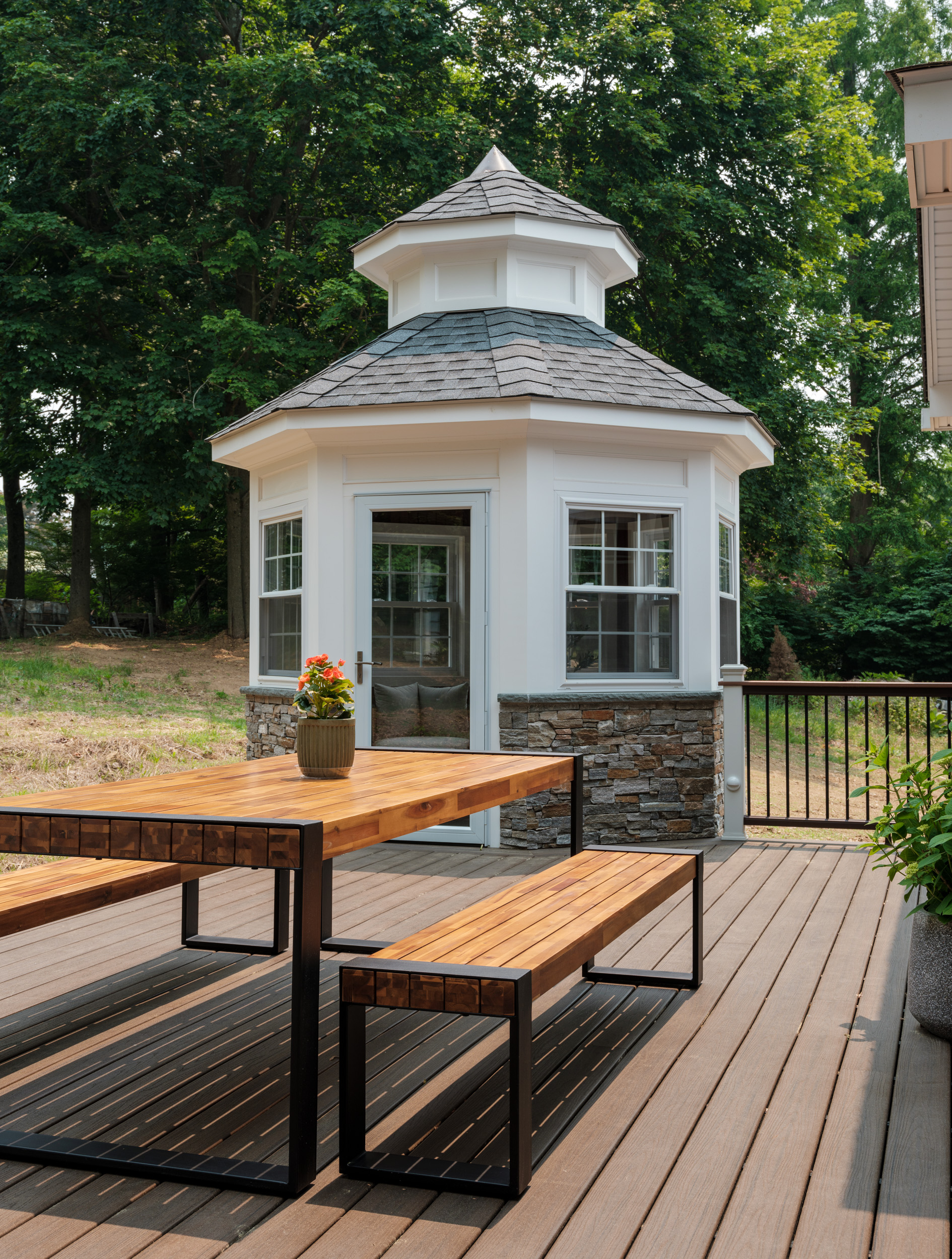How To Stain Outdoor Furniture The Right Way — "It Enhances Wood's Natural Appeal," Experts Say
Looking to bring life back into your worn out furniture? Here are some expert tips and tricks you should follow


When mother nature takes over, your outdoor furniture can take the brunt of it all and overtime, your wooden benches and metal stools will start to look a little worn out. But, instead of throwing these away, why not give them a little bit of a glow up?
'Staining outdoor furniture has its advantages and disadvantages. On the plus side, staining can enhance the natural grain of the wood, give your furniture a richer and more appealing look,' Richard Louise from Dovetails and Stitches tells us.
If you are looking for backyard ideas and inspiration, why not start by freshening up the flow of your garden? You can do this by taking care of some of the items you already own, and staining might just be the first step towards a brighter space.
Here is some expert advice on staining your outdoor furniture.
What exactly is 'staining'?

'Staining refers to the application of a pigmented or transparent finish to wood that provides color and/or protective properties,' Tony O'Neill, an expert from Simplify Gardening tell us.
Unlike paint, which sits on the surface, Tony says stains go much deeper into the wood, 'providing lasting protection while still showcasing the natural grain of the wood'.
There are also different forms of stains. These can be water-based or oil-based, and 'come in a variety of colors and transparencies, from clear seals to solid colors,' Tony adds.
The Livingetc newsletters are your inside source for what’s shaping interiors now - and what’s next. Discover trend forecasts, smart style ideas, and curated shopping inspiration that brings design to life. Subscribe today and stay ahead of the curve.
The pros of staining outdoor furniture

Josh Kou at North Castle Hardwoods says, staining wood furniture gives you the ability to choose your own colors that will 'complement your deck or decor'.
It also gives you a sense of 'ownership or craftsmanship as you customize it. And, of course, if you pick a high-quality exterior stain with UV protection, also can help the furniture last longer by protecting it from humidity changes,' Josh adds.
Climate is a big factor to consider when staining. Tim Warren a DIY expert from Adkwik points out that straining will help to protect furniture 'from the elements that may cause its condition to worsen over time, such as rain, UV rays or snow'. He says the use of a good quality stain will help 'form a barrier against moisture, which would otherwise potentially cause rot or decay'.
Tim says staining also helps increase the 'longevity,' of outdoor furniture, keeping them 'looking good for longer'.
'Stains can sometimes enhance the natural appearance of the materials used to make your furniture,' Tim explains, which in turn can 'bring out the natural colour or grain'.
In terms of styling, Tim says using wood stain allows you to 'customize the appearance of your furniture so that it can match the style of your home better'.
The cons of staining outdoor furniture
Staining might sound like a breeze, but Tim says the task can indeed be quite 'time consuming'. This is especially true if you are 'staining a large piece or doing multiple pieces at once'. It can take a few hours to apply and dry, and Tim notes that you might even need to add a few several coats, depending on the size of the furniture.
Another factor to consider when staining, is that it can be quite expensive, as Tim says 'brushes or rollers,' might also add to your costs.
Josh says that 'stain or sealant will wear out with time,' which means you'll have to stain the furniture again after 1-3 years. But he says, you can 'extend the life of the stain by covering your furniture and bringing it inside in harsh weather – which is a hassle, but is not a bad idea to do whether or not it’s stained'.
Timing matters

'You should aim to apply stain to outdoor furniture when it has not rained for a few days, and the forecast predicts that the following few days will be dry,' Tim says.
He recommends that you do not stain furniture when it is in direct sunlight, as this can dry out the stain too quickly before make 'the wood can properly absorb it'.
Josh advises if you've recently just purchased outdoor furniture and it does not come with stain, you should stain it as soon as possible. 'Definitely stain, seal, or finish it in some way before you place it outdoors at all, or it will absorb humidity and begin to suffer sun damage as soon as it goes outside'.
Is it really necessary to stain outdoor furniture?
Tim tells us that it is not 'essential to maintain outdoor furniture if it is made from high quality materials'. However, he says wooden furniture that is not 'made of teak does benefit from staining, as it will help to extend the lifespan of the wood and enhance the appearance of the wood grain'.
Before staining, Tim advises that you 'check the manufacturer's recommendations, as some furniture may benefit from being stained annually, whereas other furniture may not need it'.
Josh recommends staining 'white oak or at least finishing it with a UV-protective sealant or a clear stain'. He says 'cedar and teak have natural oils that protect them from the elements, so they’re less often stained, but can still benefit from a sealant'.
Richard Louise from Dovetails and Stitches says, you should stain and seal woods such as, pine, fir and oak as 'staining these woods helps protect against moisture absorption, sun damage, and wear, prolonging the furniture's life and maintaining its aesthetic appeal.
'Applying a stain can significantly enhance the durability and appearance of these more vulnerable woods when used outdoors. I would highly recommend a quality outdoor topcoat, like a good marine spar varnish,' He adds.
Should outdoor furniture be painted or stained?

'Choosing between painting or staining outdoor furniture depends on the desired finish and maintenance requirements,' Richard says.
He explains that staining enhances the 'natural beauty' of wood, 'allows the grain to show through, and is generally easier to maintain,' as it does not peel like paint.
Staining requires 'reapplication' to enhance color and protection, but Richard says it is 'less labor-intensive over time'.
Whereas painting 'provides a uniform color and greater protection (assuming no topcoat over a stain) against the elements,' but may require 'more frequent touch-ups due to chipping or peeling'.
'For woods that don't naturally resist decay, painting might offer an additional barrier against wear and moisture,' Richard adds.
To stain or not to stain... here's what you should consider
Richard tells us, staining should be considered in these four moments:
1. If the wood appears old or faded, as a fresh stain can revitalize its look.
2. If you notice signs of wear 'such as cracking or splintering, which can be mitigated by the protective properties of stain and topcoat'.
3. You want to change the color to 'refresh the furniture's appearance or to match new outdoor decor'.
4. And last but not least, Richard says 'before significant weather exposure, particularly if the furniture has never been stained, to ensure it is protected from the start'.
Our experts tips and tricks for staining furniture

Tim says staining wood will 'permanently change its color, so if you are not sure about the color or the type you are applying, test it on a spare piece of wood or an inconspicuous area first'.
'If you think you may have applied too much stain, wipe the excess off straight away, as otherwise it will take much longer to dry,' he adds.
Before staining, be sure to get rid of any 'inperfections' first, by sanding it down. You should then proceed to 'clean the wood so that it is free of dust and dirt. Only apply a small amount of stain at a time, and follow the direction of the wood grain'.

Faiza is the Renovation Editor at Livingetc. She previously worked for The Independent as a News Feature Writer, where she crafted lifestyle, entertainment, and news stories. She also worked as an Audience Editor for the newspaper for almost two years. Thriving in the busy newsroom, Faiza also spent her time crafting stories for Sky News as an SEO reporter, where she produced stories based on trending topics. Lifestyle and interior design have been areas of interest for her for some time, and as she advances in this field, she will continue to refine her skills in all aspects of design. Faiza has a background in SEO, social media, and reporting. Her passion for writing goes beyond her work as she loves all things poetry and creative writing.